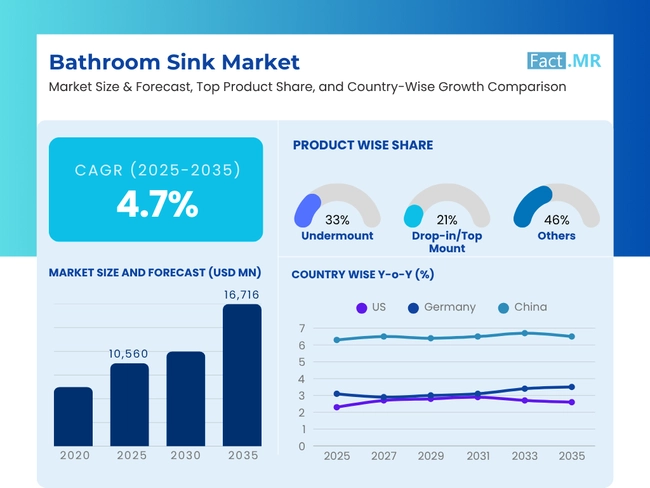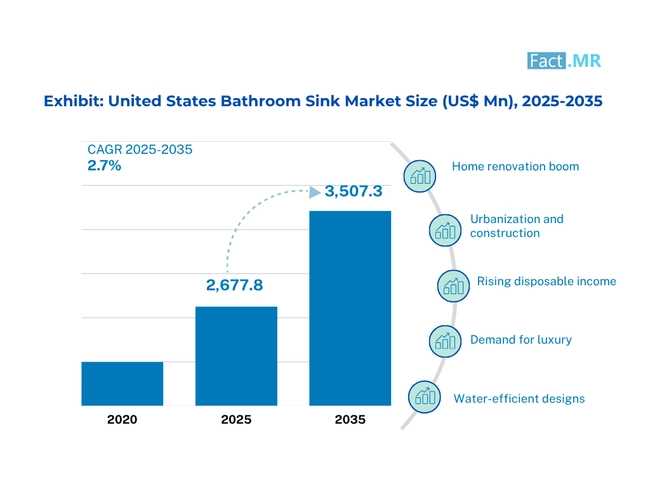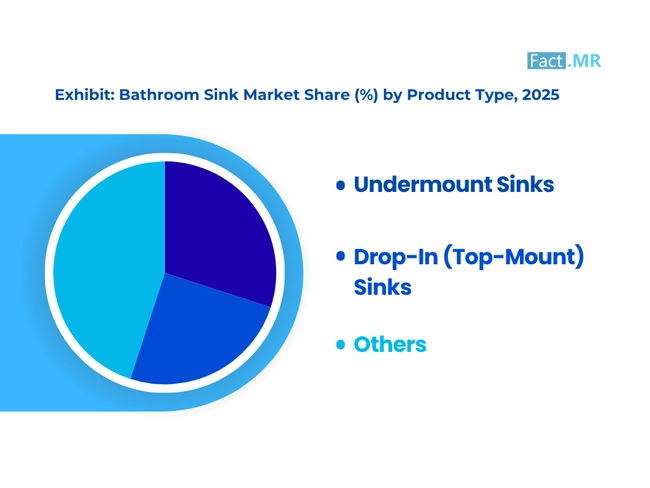Bathroom Sink Market
Bathroom Sink Market Analysis, By Product Type, By Material (Ceramic, Porcelain, Stainless Steel, and Others), By Shape, and Region - Market Insights 2025 to 2035
Analysis of Bathroom Sink Market Covering 30+ Countries Including Analysis of US, Canada, UK, Germany, France, Nordics, GCC countries, Japan, Korea and many more.
Bathroom Sink Market Outlook (2025 to 2035)
The global bathroom sink market is expected to reach USD 16,716 million by 2035, up from USD 10,148 million in 2024. During the forecast period 2025 to 2035, the industry is projected to register at a CAGR of 4.7%.
The increasing demand for updated home decor, combined with the need for space-conscious sanitation facilities, is driving the global installation of bathroom sinks. The market expansion is also promoted by urban housing development and increased disposable income, especially in developing economies.

What are the drivers of bathroom sink market?
Rapid urbanization and increasing housing construction activities worldwide are key factors driving the bathroom sink market. With the increase in the number of people in cities, particularly in emerging economies, the human need to have modern housing and sanitation infrastructure also rises.
This has enhanced the addition of bathroom sinks in new structures as well as in the renovation of homes. Additionally, the emphasis on sanitation and the aesthetic appeal of the interior environment enhances adoption, particularly of smart sinks and touchless sinks.
The role of technological advancements and consumer demand for stylish, environmentally friendly bathroom fixtures is also very important. Innovation is fueled by the demand for water-saving sink designs with improved functionality, such as inbuilt countertops and antimicrobial surfaces.
This is because premium product sales are being influenced by the increasing consumer propensity towards luxuriousness and comfort in bathroom fittings, as well as the rise in disposable income.
The development of the hospitality industry, including hotels, resorts, and business complexes, also facilitates market growth. The rise in investments in infrastructure projects in the Asia Pacific and the Middle East still offers a long-term opportunity for manufacturers of bathroom sinks.
What are the regional trends of bathroom sink market?
North America and Europe are stagnant markets that rely on innovation and product renovation to drive sales. At this level, consumers would like to eat on quality materials such as vitreous china, granite, and tempered glass.
Another thing that has high demand is eco-friendly features and touchless technology, which can improve a restaurant's popularity due to increased environmental awareness and the need for cleanliness.
The fast-growing regional market is the Asia Pacific, as the population in urban areas is increasing, household incomes are rising, and infrastructure construction is considerable. Being one of the main countries where the construction of new housing and smart cities is in high demand, modern bathroom fixtures such as wall-mounted and under-mount sinks are highly profitable.
The Middle East & Africa region has been promoting the demand of traditional and designer sinks through luxurious hospitality projects and the fast growth of real estate, particularly in the UAE, Saudi Arabia and South Africa. In the meantime, Latin America is experiencing moderate growth, driven by commercial construction and government housing programs in countries such as Brazil and Mexico.
The convergence of functionality, aesthetics, and sustainability worldwide has led to a regional trend, where manufacturers are compelled to localize their designs and offer more choices to users across various income levels.
What are the some of the key restraining factors of bathroom sink market?
The cost of quality materials and installation is a major issue encountered in the bathroom sink market. This can be a significant issue for price-conscious consumers, particularly in developing regions. High-technology products and stylish designs are often associated with additional costs of transportation, a highly qualified workforce, and service, which restrict their application to middle- and lower-income families.
The second control is the presence of substitutes, such as all-in-one vanity units or pedestal substitutes, which may reduce the sales of conventional sinks. The pressure on margins can be exerted by market disintegration and excessive competition in terms of prices by both local and foreign competitors.
Government regulations have also increased regarding non-recyclable products and water runoffs. In adherence to sustainability standards, the production process becomes more complex and expensive.
Country-Wise Outlook
China drives global bathroom sink demand through urbanization and smart manufacturing
China is a key player in the global bathroom sink market, thanks to its potent combination of economies of scale, high urban housing development rates, and the meteoric rise of consumer sophistication.
Constrained urban area housing, particularly that in an apartment, is becoming denser, so compact and integrated sink designs are much sought after. Domestic brands use massive production sites in Chaozhou and Foshan to expand both big and luxury production.
Technological integration also moves very fast, including anti-bacterial coatings, faucets with sensors, and intelligent features to monitor water. The dissemination of water-efficient products and those with low emissions is also being promoted nationwide through sustainability programs, especially at the Green Building Evaluation Standards, which further strengthens China's leadership in both quantity and innovation.
Germany elevates the bathroom sink market with precision design and green retrofits
The presence of Germany in the bathroom sink market is explained by the emphasis on sustainable design and high engineering quality. With an increase in the pace of improving the energy efficiency of buildings through retrofitting, property owners are opting to spend their money on undermount and wall-mounted sinks to display a minimalist design and a progressive touch regarding the environment.
Sections of strict EU regulations and national policies that encourage the practice of circular buildings are pushing manufacturers towards the use of recyclable ceramics and water-saving mechanisms. The incorporation of sinks into modular bathroom units is also gaining traction in the prefabricated housing and hospitality industries, enabling Germany to establish itself as a standard setter in terms of design and sustainability in Europe.
The United States leads bathroom sink innovation through remodeling and smart home integration

Due to the high demand for extensive renovations in the housing sector, coupled with demands for high-performance and design-intensive bath sinks, the United States is leading the growth in the bathroom sink market. The market is shifting toward functionality and traditional styling, as consumers prioritize features such as vessel, countertop, and ADA-compliant sinks.
Smart home trends are profoundly affecting both product development and the functional setting of the space. As such, app-controlled faucets, self-cleaning basins, and antimicrobial surfaces are now requisite in a contemporary bathroom. Additionally, the functional setting of the space is evolving, with angled basins and wall-mounted cabinets increasingly becoming common.
Supported by federal manufacturing incentives, as well as an increasing focus on greener design, American brands are merging technology, fashion, and legal standards to take bathroom infrastructure in a new direction in both residential and commercial markets.
Category-Wise Analysis
Drop-in/Top mount sinks remain a preferred choice for cost-efficient bathroom renovations
The most common form of sink is the drop-in or top-mount sink, which is also used due to its cost-effectiveness and simplicity. Over-the-ready sinks sit on the counter with an observable ledge; thus, their setup is more probable than with undermount sinks.
They are highly desirable in the DIY parts of the market, as well as for cost-effective renovations, since they complement well with the majority of countertop materials and cabinetry. The aspect of the segment is especially remarkable in new economies and price-conscious venues, where the cost of labor and customization is strictly controlled.

Ceramic sinks dominate as the go-to material for hygiene and aesthetic consistency
The bathroom sink market is still dominated by ceramic, as it has a non-porous surface, is remarkably durable, and has a classic look. Ceramic sinks are recognized as easy-to-clean options that resist staining and scratching, thereby serving both residential and commercial premises very favorably.
Additionally, the material features a broad range of color glazing and finishes, making it highly versatile for designing both modern and classic bathrooms. The fact that it has adhered to the sanitary standards and rules over the years also makes it very strong in the health market.
Rectangular shapes lead the market with space-efficient and contemporary design appeal
The rectangular type of bathroom sinks is highly capturing the market due to its flexibility with minimalistic and space-efficient bathroom designs. Their rectangular-shaped pattern promotes the use of the countertop and complements the contemporary architecture of today.
It also fits modular and wall-mounted sinks, making it more adaptable for small city living. One of the reasons why rectangular sinks are gaining popularity in both the upscale urban housing and hospitality industries is their aesthetic appeal in comparison to modern faucets and fixtures.
Competitive Analysis
The bathroom sink industry is characterized by stiff competition in terms of design and material diversification. The ability of a brand to fit perfectly into contemporary and luxury bathrooms has become a significant competitive advantage, as aesthetics play an increasingly important role in competition.
Competition is also taking place, with companies offering numerous customizable options, including under-mount, vessel, wall-mounted, and built-in countertop sink models. Consumer demand is shifting towards space-saving, minimalist, and smart-enabled fixtures, and market players are being forced to customize product design and offer new functions.
Material innovation remains a key business point of difference. Advancement in the use of ceramic, tempered glass, and sustainable composite materials is seeing an increase with user players who want to support useful environmental ideas, as well as the top-quality consumer.
The increasing demand for home renovations and the vibrant hospitality industry are also contributing to the aggressive nature of competition among key regional and global brands that aim to differentiate themselves through unique form factors and added value, such as antibacterial coatings and in-built storage.
The playing field is being transformed into distribution channel strategies. Although traditional retailing is still growing, digital commerce and direct-to-consumer (DTC) businesses are more popular currently, particularly in urban markets. Price optimization, as well as bundling with faucets or vanities, and developing virtual showroom experiences and augmented reality tools to enhance the planning of bathrooms individually, are also under competitive pressure.
Key players in the bathroom sink industry are Kohler Co., LAUFEN Bathrooms AG, LIXIL Group Corp., Meon Inc., Roca Sanitario S.A., Duravit, Huida Sanitary Ware, The London Basin Company, and other players.
Recent Development
- In March 2025, TOTO introduced Kiwami® Asymmetrical Matte Vessel Lavatories, a line of ultra‐thin‑walled sinks crafted from durable LINEARCERAM® featuring bold matte finishes like white, beige, gray, and black. These sculptural lavatories bring organic elegance and visual drama to modern bath spaces.
- In February 2025, TOTO unveiled next-generation vessel lavatories at KBIS 2025, including Matte and Color variants designed for spa-like luxury with smart, sustainable engineering that seamlessly blends design and environmental responsibility.
Fact.MR has provided detailed information about the price points of key manufacturers in the bathroom sink market, positioned across regions, including sales growth, production capacity, and speculative technological expansion, in the recently published report.
Methodology and Industry Tracking Approach
An analysis of the global bathroom sink market in 2025 by Fact.MR covered the views of more than 5,400 respondents from 18 countries, relying on the representativeness of the market.
Through the ongoing research and development conducted between June 2024 and May 2025, Fact.MR was able to take into account seasonal purchasing patterns, price changes, material ideas, and design innovation trends, particularly in the post-pandemic wellness-oriented interior climate.
The overall market perspective was cross-referenced by more than 150 legitimate sources, including journals of interior design and architecture, sanitary ware and plumbing fixtures cost monitors, codes for green buildings, and integrations of smart home gadgets.
The Brazilian bathroom fixtures market is being pivotally tracked by Fact.MR, ever since 2018, has been persistently following the industry in the same vein as water-saving mechanisms, sensor integration-based sink system designs, eco-friendly alternatives in ceramics, and the changing of consumer trends toward minimalistic aesthetics and space-saving installation patterns.
Segmentation of Bathroom sink market
-
By Product Type :
- Drop-in/Top Mount Sinks
- Undermount Sinks
- Wall-mounted Sinks
- Pedestal Sinks
- Console Sinks
- Vessel/Bowl Sinks
- Semi-recessed Sinks
- Integrated Sinks and Countertops
- Corner Sinks
-
By Material :
- Ceramic
- Porcelain
- Stainless Steel
- Glass
- Stone (Marble, Granite, etc.)
- Resin/Artificial Stone
- Concrete
- Copper
- Wood and Bamboo
-
By Shape :
- Rectangular
- Oval
- Round
- Square
- Custom/Asymmetrical Designs
-
By Region :
- North America
- Latin America
- Western Europe
- Eastern Europe
- East Asia
- South Asia & Pacific
- Middle East & Africa
Table of Content
- Executive Summary
- Industry Introduction, including Taxonomy and Market Definition
- Trends and Success Factors, including Macro-economic Factors, Market Dynamics, and Recent Industry Developments
- Global Market Demand Analysis 2020 to 2024 and Forecast 2025 to 2035, including Historical Analysis and Future Projections
- Global Market Analysis 2020 to 2024 and Forecast 2025 to 2035
- Product Type
- Material
- Shape
- Global Market Analysis 2020 to 2024 and Forecast 2025 to 2035, By Product Type
- Drop-in/Top Mount Sinks
- Undermount Sinks
- Wall-mounted Sinks
- Pedestal Sinks
- Console Sinks
- Vessel/Bowl Sinks
- Semi-recessed Sinks
- Integrated Sinks and Countertops
- Corner Sinks
- Global Market Analysis 2020 to 2024 and Forecast 2025 to 2035, By Material
- Ceramic
- Porcelain
- Stainless Steel
- Glass
- Stone (Marble, Granite, etc.)
- Resin/Artificial Stone
- Concrete
- Copper
- Wood and Bamboo
- Global Market Analysis 2020 to 2024 and Forecast 2025 to 2035, By Shape
- Rectangular
- Oval
- Round
- Square
- Custom/Asymmetrical Designs
- Global Market Analysis 2020 to 2024 and Forecast 2025 to 2035, By Region
- North America
- Latin America
- Western Europe
- South Asia & Pacific
- East Asia
- Eastern Europe
- Middle East & Africa
- North America Sales Analysis 2020 to 2024 and Forecast 2025 to 2035, by Key Segments and Countries
- Latin America Sales Analysis 2020 to 2024 and Forecast 2025 to 2035, by Key Segments and Countries
- Western Europe Sales Analysis 2020 to 2024 and Forecast 2025 to 2035, by Key Segments and Countries
- South Asia & Pacific Sales Analysis 2020 to 2024 and Forecast 2025 to 2035, by Key Segments and Countries
- East Asia Sales Analysis 2020 to 2024 and Forecast 2025 to 2035, by Key Segments and Countries
- Eastern Europe Sales Analysis 2020 to 2024 and Forecast 2025 to 2035, by Key Segments and Countries
- Middle East & Africa Sales Analysis 2020 to 2024 and Forecast 2025 to 2035, by Key Segments and Countries
- Sales Forecast to 2035 by Product Type, Material, and Shape for 30 Countries
- Competitive Assessment, Company Share Analysis by Key Players, and Competition Dashboard
- Company Profile
- Kohler Co.
- LAUFEN Bathrooms AG
- LIXIL Group Corp.
- Meon Inc.
- Roca Sanitario, S.A.
- Duravit
- Huida Sanitary Ware
- The London Basin Company
- FAQs -
What was the global Bathroom sink market size reported by Fact.MR for 2025?
The Global Bathroom sink market was valued at USD 10,560 Million in 2025.
Who are the major players operating in the Bathroom sink market?
Prominent players in the market Kohler Co., LAUFEN Bathrooms AG, LIXIL Group Corp., Meon Inc., Roca Sanitario S.A., Duravit, Huida Sanitary Ware, and The London Basin Company.
What is the Estimated Valuation of the Bathroom sink market in 2035?
The market is expected to reach a valuation of USD 16,716 Million in 2035.
What Value CAGR did the Bathroom sink market exhibit over the last five years?
The historic growth rate of the Bathroom sink market was 3.9% from 2020 to 2024.